The wiki is lacking in content. You can help by creating a new article. See the to do list for more ways you can help.
Difference between revisions of "Final Fantasy Fables: Chocobo Tales"
m |
(made article larger. still need more) |
||
| Line 2: | Line 2: | ||
{{Infobox CVG | {{Infobox CVG | ||
|title=Final Fantasy Fables: Chocobo Tales | |title=Final Fantasy Fables: Chocobo Tales | ||
|image=[[Image:FFF Chocobo Tales box art.jpg| | |image=[[Image:FFF Chocobo Tales box art.jpg|300px]] | ||
|jname=チョコボと魔法の絵本 | |jname=チョコボと魔法の絵本 | ||
|romaji=Chocobo to Mahō no Ehon | |romaji=Chocobo to Mahō no Ehon | ||
| Line 13: | Line 13: | ||
|platforms=[[Nintendo DS]] | |platforms=[[Nintendo DS]] | ||
}} | }} | ||
'''''Final Fantasy Fables: Chocobo Tales''''' is a [[Nintendo DS]] game of the ''[[Chocobo (series)|Chocobo]]'' series. It was developed by [[h.a.n.d.]] and published by [[Square Enix]] in 2007. The game features a card | '''''Final Fantasy Fables: Chocobo Tales''''' is a [[Nintendo DS]] game of the ''[[Chocobo (series)|Chocobo]]'' series. It was developed by [[h.a.n.d.]] and published by [[Square Enix]] in 2007. The game features a variety of gameplay styles, including minigames, exploration, and card battles. A lot of the gameplay involves [[Chocobo]] participating in minigames, each taking place in a different [[picture book]], which are a magical type of {{wp|pop-up book}} and the main theme of the game. | ||
==Gameplay== | ==Gameplay== | ||
[[File:Chocobo Tales gameplay image.png|thumb|left|Chocobo standing next to the first pop-up book, "The Admantoise and the Cactuar"]] | |||
The title screen features a Chocobo face, which the player must tap with a stylus to continue. By doing so, two save slots are shown from the bottom screen. When the player starts a new save file, they must first enter a name, which is used for Chocobo. | |||
The main Story Mode, where Chocobo must explore an open world and enter picture books to partake in each of their minigame and progress in the story. | |||
When Chocobo first enters a picture book, an introduction to its story is shown. After that, the minigame's selection menu shows up, with a Story option (to re-read the opening) and either a Battle Mode or a Trial Mode. Usually if a picture book features both modes, Chocobo must first complete Battle Mode to unlock Trial Mode. In Battle Mode, Chocobo must compete against rivals to try and win the minigame. Trial Mode's main difference is that Chocobo is the only participant, and the mode has no time limit and continues until Chocobo is hit three times. In either mode, the player can earn a high score by either setting the first record or beating their previous score. After Chocobo obtains the [[magic magnifying glass]], the player has the option look at extra minigame goals, each with a different reward, most often a [[pop-up card]] or a chocobo being freed from their [[chocobo card]]. | |||
Each minigame has five levels under Battle Mode, and level 1 is always available from the start. Levels 2 and 3 are often unlockable while level 4 and 5 are always unlockable. The unlock criteria is different per each minigame. Every picture book has three epilogues, which are unlocked separately when their condition is met. The epilogues usually have a happy ending or a moral, and whenever an epilogue is unlocked, a miracle occurs in the overworld area. Most of them are required so that Chocobo can progress. | |||
{{br|left}} | |||
Chocobo can interact with certain characters or even objects to play simpler types of minigames, which are known as microgames. Unlike minigames, they do not take place in a picture book and have no effect on the overworld. When Chocobo unlocks a microgame, the player can replay it from the main menu's Quick Play mode. This mode allows the player to replay minigames and microgames that were unlocked in Story Mode. | |||
Throughout Story Mode, Chocobo must collect several [[pop-up card]]s and form decks of them to use in [[pop-up duel]]s. Chocobo can obtain pop-up cards from story events, completing minigames and microgames, and from other characters. Each pop-up card has a number, and Chocobo only has one of that numbered card throughout his adventure. Many pop-up duels occur at a critical part of Chocobo's adventure, such as the four different instances where Chocobo encounters Bebuzzu in front of a [[crystal]]. Each pop-up card has a red, a blue, a yellow, and a green zone to determine their attack and defense. As such, pop-up duels are based on luck and strategy. | |||
The game has both local and online multiplayer capabilities, where 2-4 players can compete in pop-up duels and minigames. Pop-up duels are only available in Multi-Card multiplayer and if players have obtained the professional deck in adventure mode. Both Single-Card and Multi-Card multiplayer are supported for minigames. | |||
==Characters== | ==Characters== | ||
| Line 24: | Line 37: | ||
* [[Greeble]] and [[Peekaboo]], a pair of a skinny blue Chocobo and fat pink Chocobo | * [[Greeble]] and [[Peekaboo]], a pair of a skinny blue Chocobo and fat pink Chocobo | ||
* The [[Jailbird]]s, a group of black Chocobo thieves who act and dress up as stereotypical crooks | * The [[Jailbird]]s, a group of black Chocobo thieves who act and dress up as stereotypical crooks | ||
==Stories== | |||
The stories are based on ''{{wp|Aesop's Fables}}'' and ''{{wp|Grimm's Fairy Tales}}''. A [[Chocobo (species)|chocobo]] is often the main character of the story, as shown from the book's pop-out visuals seen in the story opening and epilogues. | |||
{|class="wikitable" | |||
|-style="background-color:gold" | |||
!Story | |||
!Based on | |||
|- | |||
|[[File:The Adamantoise and the Cactuar book cover.png|link=The Adamantoise and the Cactuar]] | |||
|"{{wp|The Tortoise and the Hare}}" (Vol. 1)<br>"{{wp|The Ant and the Grasshopper}}" (Vol. 2) | |||
|- | |||
|[[File:Titan and the Beanstalk book cover.png|link=Titan and the Beanstalk]] | |||
|"{{wp|Jack and the Beanstalk}}" | |||
|- | |||
|[[File:The Ugly Chocoling book cover.png|link=The Ugly Chocoling]] | |||
|"{{wp|The Ugly Duckling}}" | |||
|- | |||
|[[File:Unicorn and the Town Musicians book cover.png|link=Unicorn and the Town Musicians]] | |||
|"{{wp|The Town Musicians of Bremen}}" (Vol. 1)<br>"{{wp|The Pied Piper of Hamelin}} (Vol. 2) | |||
|- | |||
|[[File:Shiva and Ifrit book cover.png|link=Shiva and Ifrit]] | |||
|"{{wp|The North Wind and the Sun}}" | |||
|- | |||
|[[File:The Boy Who Cried Leviathan book cover.png|link=The Boy Who Cried Leviathan]] | |||
|"{{wp|The Boy Who Cried Wolf}}" | |||
|- | |||
|[[File:The Three Little Piggies book cover.png|link=The Three Little Piggies]] | |||
|"{{wp|The Three Little Pigs}}" | |||
|- | |||
|[[File:Mini Red Riding Hood book cover.png|link=Mini Red Riding Hood]] | |||
|"{{wp|Little Red Riding Hood}}"<br>"{{wp|Cinderella}}" (Vol. 1 epilogue 2 & 3) | |||
|- | |||
||[[File:Legend of the Crystals book cover.png|link=Legend of the Crystals]] | |||
|None | |||
|} | |||
==Microgames== | |||
There are a total of 23 microgames. | |||
*[[Blazing Blocks]] | |||
*[[Blizzardy Blocks]] | |||
*[[Blowgun Blitz]] | |||
*[[Boggling Bridges]] | |||
*[[Bomberwall]] | |||
*[[Bubble Bounce]] | |||
*[[Cheese Chase]] | |||
*[[Cliffhanger]] | |||
*[[Crazy Credits]] | |||
*[[Deadly Demon Wall]] | |||
*[[Jelly Jiggler]] | |||
*[[Job Juggler]] | |||
*[[Leapfrog]] | |||
*[[Magic Pot Luck]] | |||
*[[Malboro Masher]] | |||
*[[Mystifying Magnets]] | |||
*[[Redeye Rampage]] | |||
*[[Rodeo Roundup]] | |||
*[[Silly Scribbles]] | |||
*[[Tap Tap Trap]] | |||
*[[Tome Raider]] | |||
*[[Up, Up, and A-Kweh!]] | |||
*[[Wacky Wall Climb]] | |||
==Reception== | |||
*[https://www.metacritic.com/game/ds/final-fantasy-fables-chocobo-tales Metacritic]: 75/100 | |||
*[https://www.ign.com/articles/2007/04/04/final-fantasy-fables-chocobo-tales IGN]: 8.3/10 | |||
*[http://web.archive.org/web/20070930015237/http://www.rpgamer.com/games/chocobo/cmpb/reviews/cmpbstrev1.html RPGamer]: 3.5/5 | |||
==External links== | ==External links== | ||
Revision as of 07:05, May 23, 2020
Template:Infobox CVG Final Fantasy Fables: Chocobo Tales is a Nintendo DS game of the Chocobo series. It was developed by h.a.n.d. and published by Square Enix in 2007. The game features a variety of gameplay styles, including minigames, exploration, and card battles. A lot of the gameplay involves Chocobo participating in minigames, each taking place in a different picture book, which are a magical type of pop-up book and the main theme of the game.
Gameplay
The title screen features a Chocobo face, which the player must tap with a stylus to continue. By doing so, two save slots are shown from the bottom screen. When the player starts a new save file, they must first enter a name, which is used for Chocobo.
The main Story Mode, where Chocobo must explore an open world and enter picture books to partake in each of their minigame and progress in the story.
When Chocobo first enters a picture book, an introduction to its story is shown. After that, the minigame's selection menu shows up, with a Story option (to re-read the opening) and either a Battle Mode or a Trial Mode. Usually if a picture book features both modes, Chocobo must first complete Battle Mode to unlock Trial Mode. In Battle Mode, Chocobo must compete against rivals to try and win the minigame. Trial Mode's main difference is that Chocobo is the only participant, and the mode has no time limit and continues until Chocobo is hit three times. In either mode, the player can earn a high score by either setting the first record or beating their previous score. After Chocobo obtains the magic magnifying glass, the player has the option look at extra minigame goals, each with a different reward, most often a pop-up card or a chocobo being freed from their chocobo card.
Each minigame has five levels under Battle Mode, and level 1 is always available from the start. Levels 2 and 3 are often unlockable while level 4 and 5 are always unlockable. The unlock criteria is different per each minigame. Every picture book has three epilogues, which are unlocked separately when their condition is met. The epilogues usually have a happy ending or a moral, and whenever an epilogue is unlocked, a miracle occurs in the overworld area. Most of them are required so that Chocobo can progress.
Chocobo can interact with certain characters or even objects to play simpler types of minigames, which are known as microgames. Unlike minigames, they do not take place in a picture book and have no effect on the overworld. When Chocobo unlocks a microgame, the player can replay it from the main menu's Quick Play mode. This mode allows the player to replay minigames and microgames that were unlocked in Story Mode.
Throughout Story Mode, Chocobo must collect several pop-up cards and form decks of them to use in pop-up duels. Chocobo can obtain pop-up cards from story events, completing minigames and microgames, and from other characters. Each pop-up card has a number, and Chocobo only has one of that numbered card throughout his adventure. Many pop-up duels occur at a critical part of Chocobo's adventure, such as the four different instances where Chocobo encounters Bebuzzu in front of a crystal. Each pop-up card has a red, a blue, a yellow, and a green zone to determine their attack and defense. As such, pop-up duels are based on luck and strategy.
The game has both local and online multiplayer capabilities, where 2-4 players can compete in pop-up duels and minigames. Pop-up duels are only available in Multi-Card multiplayer and if players have obtained the professional deck in adventure mode. Both Single-Card and Multi-Card multiplayer are supported for minigames.
Characters
- Chocobo
- Shiroma, a White Mage
- Croma, a Black Mage
- Greeble and Peekaboo, a pair of a skinny blue Chocobo and fat pink Chocobo
- The Jailbirds, a group of black Chocobo thieves who act and dress up as stereotypical crooks
Stories
The stories are based on Aesop's Fables and Grimm's Fairy Tales. A chocobo is often the main character of the story, as shown from the book's pop-out visuals seen in the story opening and epilogues.
| Story | Based on |
|---|---|

|
"The Tortoise and the Hare" (Vol. 1) "The Ant and the Grasshopper" (Vol. 2) |
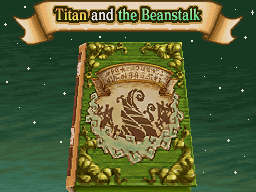
|
"Jack and the Beanstalk" |
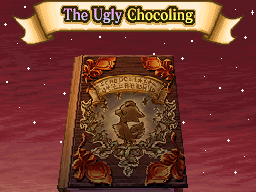
|
"The Ugly Duckling" |
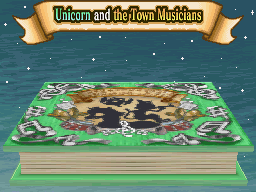
|
"The Town Musicians of Bremen" (Vol. 1) "The Pied Piper of Hamelin (Vol. 2) |
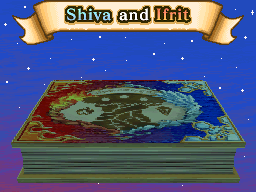
|
"The North Wind and the Sun" |
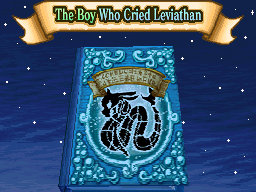
|
"The Boy Who Cried Wolf" |
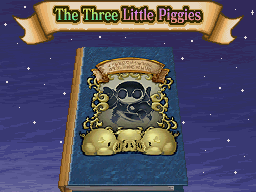
|
"The Three Little Pigs" |
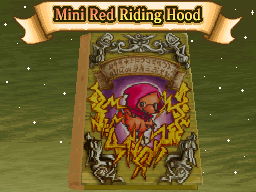
|
"Little Red Riding Hood" "Cinderella" (Vol. 1 epilogue 2 & 3) |

|
None |
Microgames
There are a total of 23 microgames.
- Blazing Blocks
- Blizzardy Blocks
- Blowgun Blitz
- Boggling Bridges
- Bomberwall
- Bubble Bounce
- Cheese Chase
- Cliffhanger
- Crazy Credits
- Deadly Demon Wall
- Jelly Jiggler
- Job Juggler
- Leapfrog
- Magic Pot Luck
- Malboro Masher
- Mystifying Magnets
- Redeye Rampage
- Rodeo Roundup
- Silly Scribbles
- Tap Tap Trap
- Tome Raider
- Up, Up, and A-Kweh!
- Wacky Wall Climb
Reception
- Metacritic: 75/100
- IGN: 8.3/10
- RPGamer: 3.5/5
External links
- Japanese website (archived)
- North American website (archived)
- European website (archived)
 This article is a stub. You can help the Final Fantasy Wiki by expanding it.
This article is a stub. You can help the Final Fantasy Wiki by expanding it.
